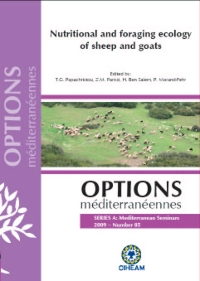| Article précédent | p. 251-254 | Article suivant |
Cellulolytic activity in the rumen of lambs fed a high concentrate diet is not affected by the removal of protozoa
Removing protozoa from the rumen may increase animal productivity. However, it is also known that protozoa play an important role in fibre degradation in the rumen. The aim of this work was to study the cellulolytic activity and microbial numbers in the rumen of faunated and protozoa free animals fed a high concentrate diet. Ten crossbred lambs were used. They were taken from the ewes within the first 24 h after birth and kept isolated from adult animals and bottle fed during 6 weeks. Once weaned five of them were given orally 10 ml of rumen fluid collected from adult sheep rumen at the slaughter house (faunated group, F). The other five lambs were given 10 ml of rumen fluid that had been previously centrifuged at 1000 g for 10 min and then frozen and thawed (protozoa free group, PF). Both groups were fed a mix of concentrate supplement and grass hay (60:40) for 5 months. Methane emissions were measured individually over a 3 day period. After slaughter, samples from the rumen were collected to study cellulose degradation using the most-probable number procedure. The numbers of Fibrobacter succinogenes, Ruminococcus flavefaciens, Ruminoccus albus and total fungi were quantified by real time PCR using specific primers and DNA isolated from rumen samples (200 mg). PF lambs produced 26% less methane than F lambs. No differences in the cellulolytic numbers were observed between groups. Real time PCR showed no differences in F. succinogenes and other cellulolytic bacteria numbers between F and PF animals. Our results show that in animals fed high concentrate diets the removal of protozoa from the rumen does not seem to affect cellulolytic activity.
La disparition des protozoaires du rumen peut augmenter la productivité animale. Néanmoins, ces micro-organismes peuvent aussi jouer un rôle important dans la dégradation des composés cellulosiques. L'objectif de ce travail était d'étudier l'activité cellulolytique et la population bactérienne présente dans le rumen des animaux avec et sans protozoaires, nourris avec un régime riche en concentré. Dix moutons séparés de leurs mères dans les 24 h qui ont suivi leur naissance, ont été isolés des adultes et nourris par allaitement artificiel pendant 6 semaines. Après leur sevrage, 5 agneaux ont reçu 10 ml du jus de rumen de brebis adultes (groupe F) et les autres 5 agneaux ont reçu 10 ml de surnageant du même jus de rumen centrifugé á 1000 g pendant 10 min, congelé et décongelé (groupe PF). Tous les moutons étaient nourris avec un mélange concentré:foin (60:40) pendant 5 mois. La production de méthane était mesurée sur chaque mouton pendant 3 jours. Après abattage, des échantillons du contenu ruminal ont été utilisés pour étudier la dégradation de la cellulose selon la méthode du nombre le plus probable. La quantité de Fibrobacter succinogenes était déterminée par PCR en temps réel en utilisant des amorces spécifiques après extraction de l'ADN des échantillons (200 mg). Il n'y a pas eu de différences entre les deux groupes de moutons concernant le nombre total de bactéries cellulolytiques ainsi que de F. succinogenes et des autres bactéries cellulolytiques. Ces résultats montrent que chez les animaux nourris avec un régime riche en concentré l'élimination des protozoaires du rumen ne semble pas affecter l'activité cellulolytique dans le rumen.
- [ Afficher ]
- [ Télécharger ]
- [ Exporter la citation ]
Vous pouvez télécharger la citation au format :
- [ Imprimer ]
-
Mots-clés
AGNEAU, ALIMENT CONCENTRE POUR ANIMAUX, DIGESTION DU RUMEN, MICRO-ORGANISME CELLULOLYTIQUE, PROTOZOA, RATIONCiter cet article
Yáñez Ruiz D.R., Martín-García A.I., Hart K.J., Molina Alcaide E., Newbold C.J. Cellulolytic activity in the rumen of lambs fed a high concentrate diet is not affected by the removal of protozoa. In : Papachristou T.G. (ed.), Parissi Z.M. (ed.), Ben Salem H. (ed.), Morand-Fehr P. (ed.). Nutritional and foraging ecology of sheep and goats. Zaragoza : CIHEAM / FAO / NAGREF, 2009. p. 251-254. (Options Méditerranéennes : Série A. Séminaires Méditerranéens; n. 85). 12. Seminar on: Nutritional and Foraging Ecology of Sheep and Goats, 2007/10/11-13, Thessaloniki (Greece). http://om.ciheam.org/om/pdf/a85/00801013.pdf



